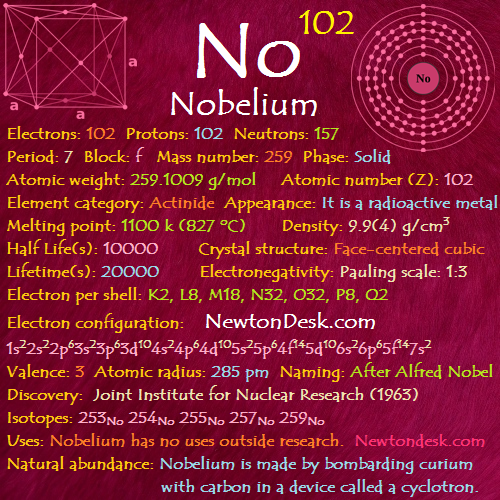82 Pb (Lead)
Appearance: Metallic gray
Standard Atomic weight: 207.2 g/mol
Mass number: 207
Atomic number (Z): 82
Electrons: 82
Protons: 82
Neutrons: 125
Group: 14
Period: 6
Block: p
Element category: Post-transition metal
Electrons per shell: K2, L8, M18, N32, O18, P4
Electron configuration: 1s22s22p63s23p63d104s24p64d105s25p64f145d106s26p2
Phase: Solid
Melting point: 600.61 K (327.46 oC)
Boiling point: 2022 K (1749 oC)
Density: 11.34 g/cm3 (In solid), 10.66 g/cm3 (When liquid at m.p)
Neutron cross section (Brans): 0.171
Heat of fusion: 4.77 kJ/mol
Heat of vaporization: 179.5 kJ/mol
Molar heat capacity: 26.650 J/(mol∙K)
Molar volume: 18.27×10-6 m3/mol
Oxidation states: 4, 3, 2, 1, -1, -2, -4
Ion charge: Pb2+, Pb4+
Electronegativity: pauling scale; 1.87
Valence: 4
Electro affinity: 35.1 kJ/mol
Ionization energies: 1st: 715.6 kJ/mol, 2nd: 1450.5 kJ/mol 3rd: 3081.5 kJ/mol
Atomic radius: empirical: 175 pm
Covalent radius: 146±5 pm
Vander Waals radius: 202 pm
Crystal structure: Face centered cubic
Grid parameters: 4.950 Å
Debye temperature: 88 K (-185.15 oC)
Sound speed: 1190 m/s
Thermal expansion: 28.9 μm/(m∙K)
Thermal conductivity: 35.3 W/(m∙K)
Electrical resistivity: 208 nΩ∙m
Magnetic ordering: Diamagnetic
Magnetic susceptibility: -23.0×10-6 cm3/mol
Volume magnetic susceptibility: -0.000017
Mass magnetic susceptibility: -1.5×10-9 m3/kg
Molar magnetic susceptibility: -3.11×10-10
Superconducting point: 7.2 K (-265.95 oC)
Young’s modulus: 16 GPa
Shear modulus: 5.6 GPa
Bulk modulus: 46 GPa
Poisson ratio: 0.44
Mohs hardness: 1.5
Brinell hardness: 38-50 MPa
CAS Number: 7439-92-1
Discovery: In the Middle East (7000 BCE)
Isotopes: 204Pb 206Pb 207Pb 208Pb
Lead Uses:
It is used in car batteries, pigments, ammunition, cable sheathing, weights for lifting, weight belts for diving, lead crystal glass, radiation protection etc..
It is often used to store corrosive liquids and It is also sometimes used in architecture, for roofing and in stained glass windows.
Biological role of Lead:
It can accumulate in the body and cause serious health problems. It is toxic, teratogenic and carcinogenic. Daily intake of lead from all sources is about 0.1 miligrams and the average human body stores approx 120 miligrams of lead in the bones.
Natural abundance of Lead:
Lead is chiefly obtained from the mineral galena by a roasting process. At least 40% of lead in the UK is recycled from secondary sources such as scrap batteries and pipes.
#lead


